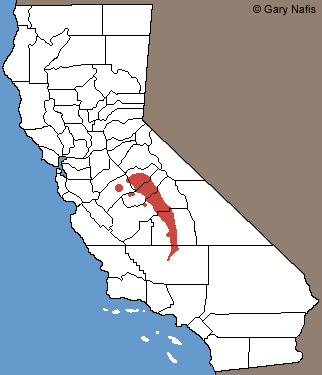
Red: Range in California
|
 |
| Adult, Kern County |
 |
 |
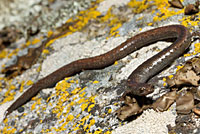 |
| |
Adult, Kern County |
|
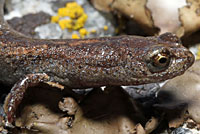 |
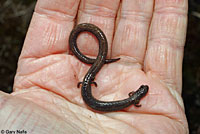 |
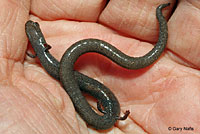 |
| Adult, Kern County |
Adult, Kern County |
Underside of adult, Kern County |
 |
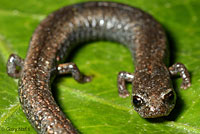 |
 |
| Adult, Kern County |
 |
 |
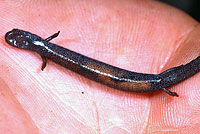 |
| Adult, Madera County |
Adult, Madera County |
Underside of adult, Madera County |
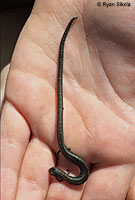 |
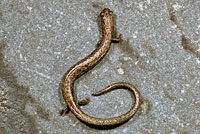 |
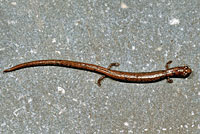 |
Adult with extraordinarily long tail,
Kern County © Ryan Sikola |
Adults, Cottonwood Creek, Kern Canyon (These salamanders were formerly thought to be Kern Canyon Slender Salamanders - B. simatus) |
 |
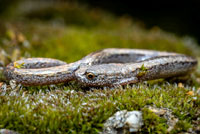 |
|
| Adult, San Joaquin Valley, Merced County © Noah Morales |
Adult, Kern County
© Zeev Nitzan Ginsburg |
|
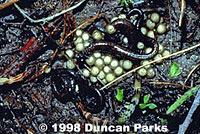 |
 |
|
These Gregarius Slender salamanders were found underneath ground debris along with some Gregarius Slender salamander eggs. As their name indicates, this species often forms communal nests, but the females typically leave the site after laying. Male and sub-adult salamanders will often still be found under the same cover as the eggs, which is probably what is seen here.
© 1998 Duncan Parks |
Slender Salamanders (genus Batrachoseps) have only 4 toes on their hind feet. All other California salamanders have 5 toes on their hind feet. |
|
| |
|
|
| Comparisons With Some Similar Sympatric Slender Salamanders |
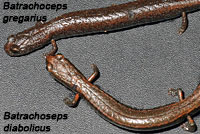 |
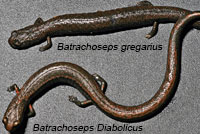 |
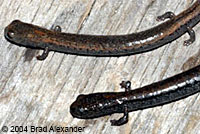 |
Top: B. gregarius
Bottom: B. diabolicus - Hell Hollow Slender Salamander
Note the somewhat larger, more robust body and limbs on B. diabolicus
|
Top: B. gregarius
Bottom: B. relictus - Relictual Slender Salamander
The ranges of these species might overlap. Note the larger, more robust body and limbs on B. relictus.
© 2004 Brad Alexander |
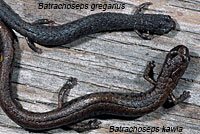 |
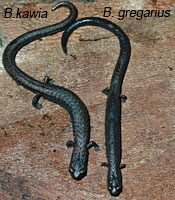 |
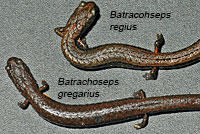 |
Top: B. gregarius
Bottom: B. kawia - Sequoia Slender Salamander
Note the larger, more robust body and limbs on B. kawia
|
Left: B. kawia - Sequoia Slender Salamander
Right: B. gregarius
Note the larger, more robust body and limbs on B. kawia
|
Top: B. regius - KIngs River Slender Salamander
Bottom: B. gregarius
B. gregarius has a slimmer body with smaller feet and toes. |
| |
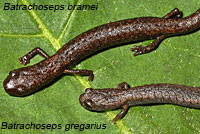 |
|
| |
Top: B. bramei - Fairview Slender Salamander
Bottom: B. gregarius
B. gregarius has a slimmer body with smaller feet and toes. |
|
| |
|
|
| Habitat |
 |
 |
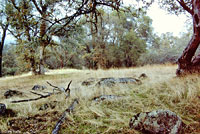 |
| Habitat, 1,600 ft., Kern County |
Habitat, 3,000 ft., Kern County |
Habitat, 1,200 ft. Mariposa County |
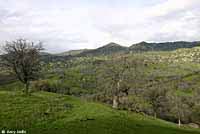 |
 |
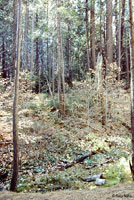 |
| Habitat, Kern County |
Habitat, 2,300 ft., Kern County |
Habitat, 4,700 ft. Mariposa County |
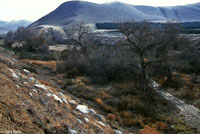 |
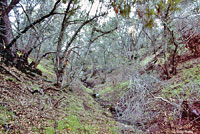 |
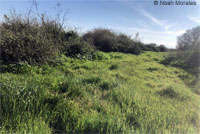 |
| Habitat, 650 ft., Kern County |
Habitat, 3,800 ft. Kern County |
Habitat, 100 ft., San Joaquin Valley Merced County © Noah Morales |
| |
|
|
| Short Videos |
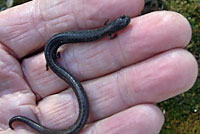 |
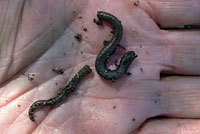 |
|
| A look at some Gregarious Slender Salamanders in the Sierra Nevada foothills of Kern County. |
As I lift a fallen branch with a Gregarious Slender Salamander underneath it, the salamander's tail comes off and begins wriggling on the ground. This is a defensive tactic used to distract a predator towards the moving tail and away from the animal which remains still. The salamander may have intentionally released its tail here, or it could have just been a result of lifting the log. I pick up the tail and you can see an edited version of it slowly wriggling to a stop. |
|
|
|
|
| Description |
| |
| Size |
Adults are 1 1/5 - 1 4/5 inches long (3 - 4.6 cm) from snout to vent.
|
| Appearance |
A small slim salamander with 17-19 costal grooves.
Short limbs, a long slender body with a narrow head and a long tail, and conspicuous costal and caudal grooves give this species the worm-like appearance typical of most Slender Salamanders.
There are four toes on the front and hind feet, which is typical of all Slender Salamanders. (Other California salamanders have five toes on the hind feet.) |
| Color and Pattern |
The ground color is dark blackish-brown with a lighter brownish dorsal stripe with tan highlights and dark flecks.
Many small white spots mark the ground color.
The venter is lighter, dark to pale gray.
|
| Life History and Behavior |
A member of family Plethodontidae, the Plethodontid or Lungless Salamanders.
Plethodontid salamanders do not breathe through lungs. They conduct respiration through their skin and the tissues lining their mouth. This requires them to live in damp environments on land and to move about on the ground only during times of high humidity. (Plethodontid salamanders native to California do not inhabit streams or bodies of water but they are capable of surviving for a short time if they fall into water.)
Plethodontid salamanders are also distinguished by their nasolabial grooves, which are vertical slits between the nostrils and upper lip that are lined with glands associated with chemoreception.
All Plethodontid Salamanders native to California lay eggs in moist places on land.
The young develop in the egg and hatch directly into a tiny terrestrial salamander with the same body form as an adult.
(They do not hatch in the water and begin their lives as tiny swimming larvae breathing through gills like some other types of salamanders.)
|
| Activity |
Surface-active from the beginning of the fall rains until the end of the rainy period, which is typically from late October or November to March or April.
It is presumed that they go underground to avoid the extreme temperatures of winter and summer.
Typically found under rocks, logs, bark, and other debris.
|
| Defense |
Slender salamanders use several defense tactics, including:
- Coiling and remaining still, relying on cryptic coloring to avoid detection.
- Uncoiling quickly and springing away repeatedly bouncing over the ground, then remaining still again to avoid detection.
- Detaching the tail, which wriggles on the ground to distract a predator from the salamander long enough for it to escape.
(After its tail is detached or severed, the salamander will grow a new tail.) |
| Diet and Feeding |
Most likely eats a variety of small invertebrates.
Feeding behavior is not known, but other Batrachoseps species are sit-and-wait predators that use a projectile tongue to catch prey. |
| Reproduction |
Reproduction is terrestrial.
Breeding and egg laying occurs with the beginning of fall rains, which varies from year to year and with elevation (typically November to early January at lower elevations, and late March to late April at higher elevation locations.) |
| Eggs |
Females lay eggs in communal nests in the spring (fall in southern populations) in moist places under rocks, logs, bark, or leaf litter.
Females then abandon the nests.
Nest sites have been found with from 10 - 300 eggs.
Females at the northern end of the range of the species lay more eggs (an average of 15.3 eggs) than those at the southern end of the range (an average of 7.3 eggs) according to a 1997 study by Jockusch and Mahoney. |
| Young |
Young develop completely in the egg and hatch fully formed.
|
| Habitat |
Mostly found in oak woodlands in the foothills, but they are also found in high-elevation coniferous forests, and grasslands on the floor of the Central Valley, including very hot and dry habitats at the southern end of its range.
|
| Geographical Range |
Endemic to California. Occurs along the west slope of the central and southern Sierra Nevada Mountains from the southern boundary of Yosemite National Park almost to the Kern River. They follow some drainages down from the Sierra Nevada foothills onto the floor of the Central Valley, including around Merced, Chowchilla, Berenda Slough in Madera County, Porterville, and the San Joaquin River north of Fresno.
Occurs in sympatry with B. kawia, and possibly with B. relictus, B. regius, B. attenuatus, and B. diabolicus. |
| Elevational Range |
Occurs from around 100 ft. to 5,900 ft. (30 - 1800 m.)
|
| Notes on Taxonomy |
Prior to its description in 1998, B. gregarius was recognized as B. nigriventris. Lower elevation southern populations are more slender, live in much drier habitats, lay fewer eggs than those in the north, and lay eggs in the fall. Future studies may establish that these are two different forms.
Here's a Diagram of the Batrachoseps Complex showing the relationships between species.
Alternate and Previous Names (Synonyms)
Batrachoseps gregarius - Gregarious Slender Salamander (Jockusch, Wake & Yanev 1998, 2003, 2012)
Batrachoseps nigriventris - Black-bellied Slender Salamander (Stebbins 1985)
Batrachoseps attenuatus - California Slender Salamander (Stebbins 1954, 1966)
Batrachoseps attenuatus attenuatus - Worm-salamander (Bishop 1943)
Batrachoseps attenuatus - Slender Salamander (Storer 1925)
Batrachoseps nigriventris (Cope 1869)
Batrachoseps attenuatus (Cooper 1868)
Batrachoseps attenuata (Baird 1850)
Salamandrina attenuata (Eschscholtz 1833)
|
| Conservation Issues (Conservation Status) |
| Listed as imperiled by one organization, though there are no apparent issues with this salamander other than some possible loss of habitat at the eastern edge of the Central Valley to development and agriculture. |
|
| Taxonomy |
| Family |
Plethodontidae |
Lungless Salamanders |
Gray, 1850 |
| Genus |
Batrachoseps |
Slender Salamanders |
Bonaparte, 1841 |
Species
|
gregarius |
Gregarious Slender Salamander |
Jockusch, Wake & Yanev 1998 |
|
Original description |
Jockusch, E. L., D. B. Wake, and K. P. Yanev. "New species of slender salamanders, Batrachoseps
(Amphibia: Plethodontidae), from the Sierra Nevada of California." Contributions in Science, Natural History
Museum of Los Angeles County, #472 1998.
|
|
Meaning of the Scientific Name |
Batrachoseps - Greek - batrachos = amphibian, frog + seps = lizard — describes lizard-like appearance
gregarius - Latin = flock or herd, referring to the habit of laying eggs communally
from Scientific and Common Names of the Reptiles and Amphibians of North America - Explained © Ellin Beltz
|
|
Similar Neighboring Salamanders |
B. diabolicus
B. regius
B. kawia
B. relictus
|
|
More Information and References |
California Department of Fish and Wildlife
AmphibiaWeb
Hansen, Robert W. Kern River Research Area Field Notes Spring 1997 Vol. 6, No. 2
Hansen, Robert W. and Shedd, Jackson D. California Amphibians and Reptiles. (Princeton Field Guides.) Princeton University Press, 2025.
Stebbins, Robert C., and McGinnis, Samuel M. Field Guide to Amphibians and Reptiles of California: Revised Edition (California Natural History Guides) University of California Press, 2012.
Stebbins, Robert C. California Amphibians and Reptiles. The University of California Press, 1972.
Flaxington, William C. Amphibians and Reptiles of California: Field Observations, Distribution, and Natural History. Fieldnotes Press, Anaheim, California, 2021.
Nicholson, K. E. (ed.). 2025. Scientific and Standard English Names of Amphibians and Reptiles of North America North of Mexico, with Comments Regarding Confidence in Our Understanding. Ninth Edition. Society for the Study of Amphibians and Reptiles. [SSAR] 87pp.
Samuel M. McGinnis and Robert C. Stebbins. Peterson Field Guide to Western Reptiles & Amphibians. 4th Edition. Houghton Mifflin Harcourt Publishing Company, 2018.
Stebbins, Robert C. A Field Guide to Western Reptiles and Amphibians. 3rd Edition. Houghton Mifflin Company, 2003.
Behler, John L., and F. Wayne King. The Audubon Society Field Guide to North American Reptiles and Amphibians. Alfred A. Knopf, 1992.
Robert Powell, Roger Conant, and Joseph T. Collins. Peterson Field Guide to Reptiles and Amphibians of Eastern and Central North America. Fourth Edition. Houghton Mifflin Harcourt, 2016.
Powell, Robert., Joseph T. Collins, and Errol D. Hooper Jr. A Key to Amphibians and Reptiles of the Continental United States and Canada. The University Press of Kansas, 1998.
American Museum of Natural History - Amphibian Species of the World 6.2
Bartlett, R. D. & Patricia P. Bartlett. Guide and Reference to the Amphibians of Western North America (North of Mexico) and Hawaii. University Press of Florida, 2009.
Bishop, Sherman C. Handbook of Salamanders. Cornell University Press, 1943.
Lannoo, Michael (Editor). Amphibian Declines: The Conservation Status of United States Species. University of California Press, June 2005.
Petranka, James W. Salamanders of the United States and Canada. Smithsonian Institution, 1998.
|
|
|
The following conservation status listings for this animal are taken from the April 2024 State of California Special Animals List and the April 2024 Federally Listed Endangered and Threatened Animals of California list (unless indicated otherwise below.) Both lists are produced by multiple agencies every year, and sometimes more than once per year, so the conservation status listing information found below might not be from the most recent lists. To make sure you are seeing the most recent listings, go to this California Department of Fish and Wildlife web page where you can search for and download both lists:
https://www.wildlife.ca.gov/Data/CNDDB/Plants-and-Animals.
A detailed explanation of the meaning of the status listing symbols can be found at the beginning of the two lists. For quick reference, I have included them on my Special Status Information page.
If no status is listed here, the animal is not included on either list. This most likely indicates that there are no serious conservation concerns for the animal. To find out more about an animal's status you can also go to the NatureServe and IUCN websites to check their rankings.
Check the current California Department of Fish and Wildlife sport fishing regulations to find out if this animal can be legally pursued and handled or collected with possession of a current fishing license. You can also look at the summary of the sport fishing regulations as they apply only to reptiles and amphibians that has been made for this website.
|
| Organization |
Status Listing |
Notes |
| NatureServe Global Ranking |
|
|
| NatureServe State Ranking |
|
|
| U.S. Endangered Species Act (ESA) |
None |
|
| California Endangered Species Act (CESA) |
None |
|
| California Department of Fish and Wildlife |
None |
|
| Bureau of Land Management |
None |
|
| USDA Forest Service |
None |
|
| IUCN |
|
|
|
|
|








































